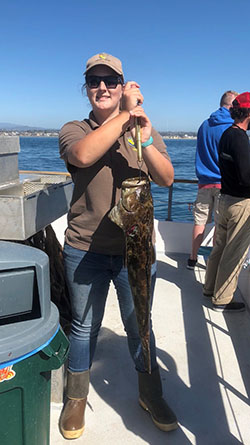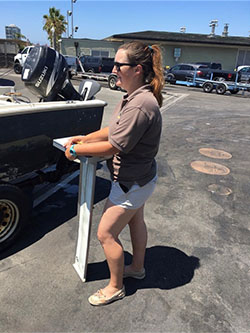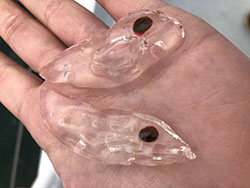
Alaina Conrad, a Scientific Aid in the California Recreational Fisheries Survey (CRFS) program holding a lingcod for weight and measurement caught off the coast of San Diego. The CRFS program collects data on angler activities, including fishing recreational sport fishing boats, man-made fishing structures (piers and jetties) and beaches and banks along the California coast. These data are then used to estimate total marine recreational finfish catch and effort in California.

Alaina Conrad, a Scientific Aid in the California Recreational Fisheries Survey (CRFS) program prepares to speak to anglers in the San Diego Area about their finfish catch. She and the other sci aids in the CRDF program interview anglers about their day of fishing, including where they fished, depth, targeted species and other information that is used to estimate marine recreational finfish catch in state waters.

Alaina Conrad, a Scientific Aid in the California Recreational Fisheries Survey (CRFS) program holds two Salps, a deep water organism, and rarely seen on the surface, that were caught in a fishing line on a sport fishing boat.
Alaina Conrad is a Fish and Wildlife Scientific Aid in CDFW’s Marine Region. Based in San Diego, she works on the California Recreational Fisheries Survey (CRFS). The CRFS is a coordinated sampling survey designed to gather catch and effort data from anglers in all modes of marine recreational finfish fishing. Alaina is one of about 70 CRFS samplers statewide. She collects data on angler activities, including recreational fishing boats, man-made fishing structures (piers and jetties) and beaches and banks along the California coast. These data are used to estimate total marine recreational finfish catch and effort in California.
Alaina earned a Bachelor of Science degree in Marine Biology from Texas A&M University at Galveston. She was based at the university’s satellite campus in the Gulf of Mexico, which focuses on all things related to the ocean – from chemistry and biology to marine literature and maritime business. She has been with CDFW since June of 2017.
What inspired you to pursue a career in marine biology?
I grew up in Monterey and was fortunate to take a marine science class in my sophomore year of high school. My teacher inspired me to learn more about the ocean and what dwells within it. Throughout high school, I volunteered at the world-renowned Monterey Bay Aquarium, taking every opportunity to learn more about the aquarium and its animals through job shadows and extra classes in the evenings.
How did your university experiences prepare you for your career?
While attending Texas A&M, I traveled to Alaska and Greece to help graduate students collect data through destination research courses. In Alaska, we collected data on the local sea otter population to monitor its overall health and recovery. In Greece, we researched the local dolphin populations, tracking their movements and determining if the population was a transient or resident pod. We also studied the sustainability of the local fisheries and their farming practices. I also had the opportunity to study in the Marine Mammal Behavioral Ecology Group, identifying individual dolphins throughout consecutive years in various places around the world. The data was being used to determine if the pods were residential or transient and if they were present all year or just at certain seasons.
My last summer in college, I was able to volunteer with the Houston Audubon Society and American Bird Conservancy as a nest site steward. Galveston Island is a nesting site for Piping Plovers and Least Terns. Both birds nest on the ground during a high traffic time – summer vacation. As a volunteer, I would educate beachgoers about the birds and how best to avoid disturbing them with friendly reminders to remain outside the roped areas and keeping their dogs on leashes. Species counts were also taken at the beginning of the shifts and nest sites were visited in order to determine the health of the nest and local population.
You just passed your first anniversary working for CDFW’s CRFS program. How does this statewide survey effort benefit the fishery?
CRFS plays a very important role in the sustainability of our local fisheries by collecting fishery-dependent data on California’s marine recreational fisheries and estimating catch and effort. These data provide fisheries managers with the best possible science needed for management decisions.
What is your typical survey day like?
Upon arrival at the sample sites, a starting count of anglers (or trailers) is taken to help determine the effort at or originating from the site. As anglers are leaving, we interview them and ask questions about their fishing trip. We ask questions like what time they began fishing at that location, or – if they were on a boat – we get a launch time in order to determine the length of time of their trip. We also ask where they were fishing and at what depth, in order to collect data on areas that are being fished. A target species is notated as well as all catch whether kept or released. If they have kept fish, we will take weight and length measurements of the fish as well as a total number of each species. Lastly, we will collect a zip code, number of anglers in the group and number of days fished over the past 12 months in order to determine where people are coming from to fish and how much effort they exhibit over a year.
What do anglers think of the surveys?
Most of the time, anglers are receptive to the surveys and understand that it helps to maintain sustainable fisheries. I have had anglers thank me for doing my job many of them are excited to see us out there helping to monitor the health of the fisheries. There are always a few people in a hurry, or who have had a bad day and will refuse to answer questions, in which case I will just move on to the next angler.
What’s the most interesting thing you have seen doing your surveys?
I get to see a variety of interesting things while at work but the most fascinating to me was a colony of Salps that got tangled on an angler’s line while on a sport fishing boat. She pulled up her line and a colony of around 20-30 individuals were wrapped around her line. As the line was pulled out of the water, the colony broke apart, but a few were left stuck to the line. Many of the anglers (deckhands included) thought the “alien” looking creature was a kind of egg sac. They are oblong and clear with a deep orange/red ball in the upper corner. Salps are a deep water organism that don’t get to be seen often, especially not held in the palm of your hand.
What do you like most about working for CDFW?
I enjoy constantly learning about new species and discovering new information about those I am familiar with already! I also enjoy being able to discuss conservation efforts with some of the anglers and hearing their stories from growing up and seeing how much the fisheries have changed.
Is there a particular species or project that you’d like to learn more about?
I have always been fascinated by the intelligence of octopus. I would enjoy getting to study them more closely in the future. I am also very interested in population dynamics of Ornithology and habitat usage and conservation for nesting grounds of threatened species.
You’re still early in your career. What would you like to be doing in 10 years?
In 10 years I hope to be involved in conservation research and public education hopefully involving either cephalopods or marsh birds and habitats.
CDFW photos courtesy of Alaina Conrad